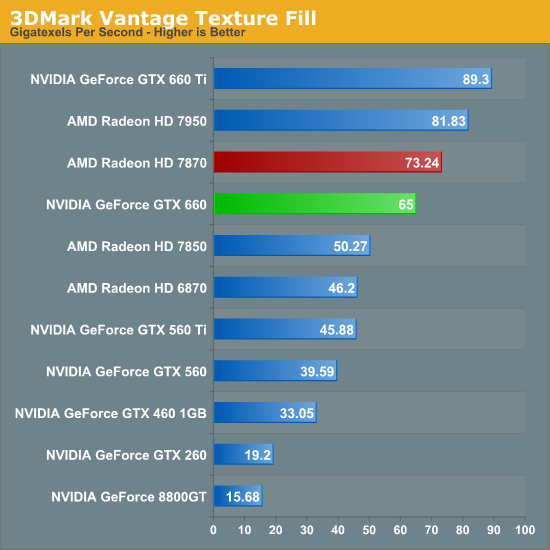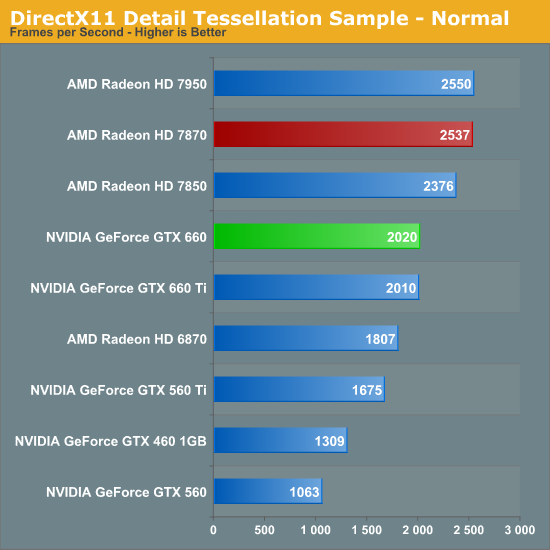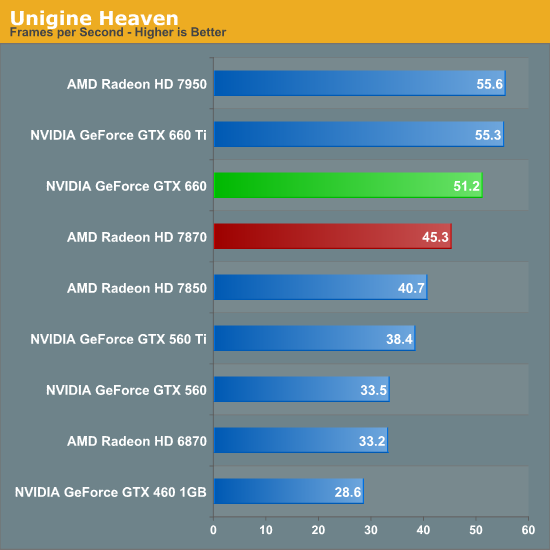The NVIDIA GeForce GTX 660 Review: GK106 Fills Out The Kepler Family
by Ryan Smith on September 13, 2012 9:00 AM ESTSynthetics
As always we’ll also take a quick look at synthetic performance to see if NVIDIA’s core configuration has had any impact on basis performance metrics. We’re expecting to see performance very close to the GTX 660 Ti, due to its nearly identical ROP/L2/memory configuration. We’ll start with 3DMark Vantage’s Pixel Fill test.

3DMark Vantage’s pixel fill test likes memory bandwidth and ROP performance in that order, which makes these results a bit odd. With identical memory bandwidth between them we’d expect the GTX 660 and GTX 660 Ti to at least be tied here, if not a slight lead for the GTX 660 thanks to its higher ROP performance. Instead the GTX 660 trails the GTX 660 Ti by a slight amount, an outcome we can’t explain at this time.

Our texture fillrate benchmark on the other hand sees a large gap between the GTX 660 and GTX 660 Ti, which is what we would expect from the loss of SMXes.
Our third theoretical test is the set of settings we use with Microsoft’s Detail Tessellation sample program out of the DX11 SDK


Despite the loss of SMXes (and thereby Polymorph engines), our tessellation benchmarks don’t show any kind of significant difference between the GTX 660 and GTX 660 Ti. We’ve been finding this benchmark to be surprisingly sensitive to ROP performance and memory bandwidth on Kepler, and these results back that finding.
Our final theoretical test is Unigine Heaven 2.5, a benchmark that straddles the line between a synthetic benchmark and a real-world benchmark as the engine is licensed but no notable DX11 games have been produced using it yet.

Despite its advanced nature, Heaven isn’t particularly sensitive to the loss of shader and texturing performance, as signified by the performance loss of less than 10% for the GTX 660.










147 Comments
View All Comments
Margalus - Thursday, September 13, 2012 - link
you say the stock 660 looks bad when compared to an overclocked 7870? what a shock that is!I guess it's always fair to say an nvidia card is bad when comparing the stock reference nv card to overclocked versions of it's nearest amd competitor..
Patflute - Friday, September 14, 2012 - link
Be fair and over clock both...poohbear - Thursday, September 13, 2012 - link
well after reading this im still have with my Gigabyte OC gtx 670 i got 2 months ago for $388. I will NOT be upgrading for 3 years & im confident my GTX 670 will still be in the upper segment in 3 years (like my 5870 that i upgraded from), so @ $130/yr its a great deal.poohbear - Thursday, September 13, 2012 - link
erm, i meant i'm still happy*. sucks that u can't edit on these comments.:pKineticHummus - Friday, September 14, 2012 - link
i had no idea what you meant with your "im still happy" edit until I went back to read your original statement again. somehow I mentally replaced the "have" with "happy" lol. reading fail for me...distinctively - Thursday, September 13, 2012 - link
Looks like the 660 is getting a nasty little spanking from the 7870 when you look around at all the reviews. The GK 106 appears to loose in just about every metric compared to Pitcairn.Locateneil - Thursday, September 13, 2012 - link
I just built a PC with 3770K and Asus Z77-v Pro, I was think to buy GTX 670 for my system but now I am now confused if it is better to go with 2 GTX 660 in SLI?Ryan Smith - Friday, September 14, 2012 - link
Our advice has always been to prefer a single more powerful card over a pair of weaker cards in SLI. SLI is a great mechanism to extend performance beyond what a single card can provide, but its inconsistent performance and inherent drawbacks (need for SLI profiles and microstuttering) means that it's not a good solution for when you can have a single, more powerful GPU.knghtwhosaysni - Thursday, September 13, 2012 - link
Do you guys think you could show frametimes like techreport does in your reviews? It can show some deficiencies in rendering that average FPS doesn't, like with Crysis 2 http://techreport.com/review/23527/nvidia-geforce-...It's nice that techreport does it, but I think Anandtech is the first stop for a lot of people who are looking for benchmarks, and I think if you guys showed this data in your own reviews then it would really push AMD and Nvidia to iron out their latency spike problems.
Ryan Smith - Friday, September 14, 2012 - link
We get asked this a lot. I really like Scott's methodology there, so if we were to do this I'd want to do more than just copy him by finding some way to do better than him (which is no easy task).To that end I find FRAPS to be at a higher level than I'd like. It's measuring when frames are handed off to the GPU rather than when the GPU actually finishes the frame. These times are strongly correlated, but I'd rather have more definitive low-level data from the GPU itself. If we could pull that off then frametimes are definitely something we'd look in to.